29. Two stereo speakers are separated are separated by a distance of 2.40 m. A person stands at a distance of 3.20 m directly in front of one of the speakers as shown in figure. Find the frequencies in the audible range (20-20000 Hz) for which the listener will hear a minimum sound intensity. Speed of sound in air = 320 m/s.
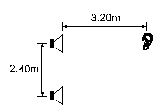
Ans. 200 (2n + 1) Hz where n = 0, 1, 2, ....... 49
30. Two sources of sound, S1 and S2, emitting waves of equal wavelength 20.0 cm, are placed with a separation of 20.0 cm between them. A detector can be moved on a line parallel to S1S2 and at a distance of 20.0 cm from it. Initially, the detector is equidistant from the two sources. Assuming that the waves emitted by the sources are in phase, find the minimum distance through which the detector should be shifted to detect a minimum of sound.
Ans. 12.6 cm
31. Two speakers, S1 and S2, driven by the same amplifier, are placed at y = 1.0 m and y = – 1.0 m (figure). The speakers vibrate in phase at 600 Hz. A man stands at a point on the X-axis at a very large distance from the origin and starts moving parallel to the Y-axis. The speed of sound in air is 330 m/s.
(a) At what angle q will the intensity of sound drop to a minimum for the first time?
(b) At what angle will he hear a maximum of sound intensity for the first time?
(c) If the continues to walk along the line, how many more maxima can he hear?
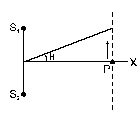
Ans. (a) 7.9° (b) 16° (c) two
32. Three sources of sound S1, S2 and S3 of equal intensity are placed in a straight line with
S1S2 = S2S3 (figure). At a point P, far away from the sources, the wave coming from S2 is 120° ahead in phase of that from S1. Also, the wave coming from S3 is 120° ahead of that from S2. What would be the resultant intensity of sound at P?
![]()
Ans. zero
33. Two coherent narrow slits emitting sound of wavelength l in the same phase are placed parallel to each other at a small separation of 2 LEMDA. The sound is detected by moving a detector on the screen S at a distance D (>> l) from the slit S1 as shown in figure. Find the distance x such that the intensity at P is equal to the intensity at O.

Ans. 30.5 D
34. Figure shows two coherent sources S1 and S2 which emit sound of wavelength l in phase. The separation between the sources is 3l. A circular wire of large radius is placed in such a way that S1 S2 lies in its plane and the middle point of S1 S2 is at the centre of the wire. Find the angular positions q on the wire for which constructive interference takes place.
Ans. 0°, 48.2°, 70.5°, 90° and similar points in other quadrants
35. Two sources of sound S1 and S2 vibrate at same frequency and are in phase (figure). The intensity of sound detected at a point P as shown in the figure is I0.
(a) if THETA equals 45°, what will be the intensity of sound detected at this point if one of the sources is switched off?
(b) What will be the answer of the previous part if THETA = 60°?
Ans. (a) I0/4 (b) I0/4
36. Find the fundamental, first overtone and second overtone frequencies of an open organ pipe of length 20 cm. Speed of sound in air is 340 m/s.
Ans. 850 Hz, 1700 Hz and 2550 Hz
37. A closed organ pipe can vibrate at a minimum frequency of 500 Hz. Find the length of the tube. Speed of sound in air = 340 m/s.
Ans. 17 cm
38. In a standing wave pattern in a vibrating air column, nodes are formed at a distance of 4.0 cm. If the speed of sound in air is 328 m/s, what is the frequency of the source?
Ans. 4.1 kHz
39. The separation between a node and the next antinode in a vibrating air column is 25 cm. If the speed of sound in air is 340 m/s, find the frequency of vibration of the air column.
.
Ans. 340 Hz
40. A cylindrical metal tube has a length of 50 cm and is open at both ends. Find the frequencies between 1000 Hz and 2000 Hz at which the air column in the tube can resonate. Speed of sound in air is 340 m/s.
Ans. 1020 Hz, 1360 Hz and 1700 Hz
41. In a resonance column experiment, a tuning fork of frequency 400 Hz is used. The first resonance is observed when the air column has a length of 20.0 cm and the second resonance is observed when the air column has a length of 62.0 cm. (a) Find the speed of sound in air. (b) How much distance above the open end does the pressure node form?
Ans. (a) 336 m/s (b) 1 cm
42. The first overtone frequency of a closed organ pipe P1 is equal to the fundamental frequency of an open organ pipe P2. If the length of the pipe P1 is 30 cm, what will be the length of P2?
Ans. 20 cm
43. A copper rod of length 1.0 m is clamped at its middle point. Find the frequencies between 20 Hz-20,000 Hz at which standing longitudinal waves can be set up in the rod. The speed of sound in copper is 3.8 km/s.
Ans. 1.9 n kHz where n = 1, 2, 3, ........, 10
44. Find the greatest length of an organ pipe open at both ends that will have its fundamental frequency in the normal hearing range (20-20,000 Hz). Speed of sound in air = 340 m/s.
Ans. 8.5 m
45. An open organ pipe has a length of 5 cm. (a) Find the fundamental frequency of vibration of this pipe. (b) what is the highest harmonic of such a tube that is in the audible range is in the audible range ? speed of sound in air is 340 ms/ and the audible range is 20-20,000 Hz.
Ans. (a) 3.4 kHz (b) 5
46. An electronically driven loudspeaker is placed near the open end of a resonance column apparatus. The length of air column in the tube is 80 cm. The frequency of the loudspeaker can be varied between 20 Hz-2kHz. Find the frequencies at which the column will resonate. Speed of sound in air = 320 m/s.
Ans. 100 (2n + 1) Hz where n = 0, 1, 2, 3, ...., 9
47. Two successive resonance frequencies in an open organ pipe are 1944 and 2592 Hz. Find the length of the tube. The speed of sound in air is 324 m/s.
Ans. 25 cm
48. A piston is fitted in a cylindrical tube of small cross-section with the other end of the tube open. The tube resonates with a tuning fork of frequency 512 Hz. The piston is gradually pulled out of the tube and it is found that a second resonance occurs when the piston is pulled out of the tube through a distance of 32.0 cm. Calculate the speed of sound in the air of the tube.
Ans. 328 m/s
49. A U-tube having unequal arm-lengths has water in it. A tuning fork of frequency 440 Hz can set up the air in the shorter arm in its fundamental mode of vibration and the same tuning fork can set up the air in the longer arm in its first overtone vibration. Find the length of the air columns. Neglect any end effect and assume that the speed of sound in air = 330 m/s.
Ans. 18.8 cm, 56.3 cm
50. Consider the situation shown in figure. The wire which has a mass of 4.00 g oscillates in its second harmonic and sets the air column in the tube into vibrations in its fundamental mode. Assuming that the speed of sound in air is 340 m/s, find the tension in the wire.
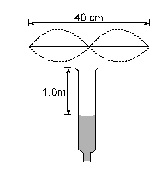
Ans. 11.6 N
51. A 30.0 cm long wire having a mass of 10.0 g is fixed at the two ends and is vibrated in its fundamental mode. A 50.0 cm long closed organ pipe, placed with its open end near the wire, is set up into resonance in its fundamental mode by the vibrating wire. Find the tension in the wire. Speed of sound in air = 340 m/s.
s
Ans. 347 N
52. Show that if the room temperature changes by a small amount from T to T + DELTA T, the fundamental frequency of an organ pipe changes from v to v + DELTA v, where
= ![]()
53. The fundamental frequency of a closed pipe is 293 Hz when the air in it is at a temperature of 20°C. What will be its fundamental frequency when the temperature changes to 22°C?
Ans. 294 Hz
54. A Kundt’s tube apparatus has a copper rod of length 1.0 m clamped at 25 cm from one of the ends. The tube contains are in which the speed of sound is 340 m/s. The powder collects in heaps separated by a distance of 5.0 cm. Find the speed of sound waves in copper.
Ans. 3400 m/s
55. A Kundt’s tube apparatus has a steel rod of length 1.0 m clamped at the centre. It is vibrated in its fundamental mode at a frequency of 2600 Hz. The lycopodium powder dispersed in the tube collects into heaps separated by 6.5 cm. Calculate the speed of sound in steel and in air.
Ans.5200 m/s, 338 m/s
56. A source of sound with adjustable frequency produces 2 beats per second with a tuning fork when its frequency is either 476 hz. or 480 Hz. What is the frequency of the tuning fork?
Ans.478 Hz
57. A tuning fork produces 4 beats per second with another tuning fork of frequency 256 Hz. The first one is now loaded with a little wax and the beat frequency is found to increase to 6 per second. What was the original frequency of the tuning fork?
Ans.252 Hz
58. Calculate the frequency of beats produced in air when two sources of sound are activated, one emitting a wavelength of 32 cm and the other of 32.2 cm. The speed of sound in air is 350 m/s.
Ans. 7 per second
59. A tuning fork of unknown frequency makes 5 beats per second with another tuning fork which can cause a closed organ pipe of length 40 cm to vibrate in its fundamental mode. The beat frequency decreases when the first tuning fork is slightly loaded with wax. Find its original frequency. The speed of sound in air is 320 m/s.
Ans. 205 Hz
60. A piano wire A vibrates at a fundamental frequency of 600 Hz. A second identical wire B produces 6 beats per second with it when the tension in A is slightly increased. Find the ratio of the tension in A to the tension in B.
Ans. 1.02
61. A tuning fork of frequency 256 Hz produces 4 beats per second with a wire of length 25 cm vibrating in its fundamental mode. The beat frequency decreases when the height of slightly shortened. What could be the minimum length by which the wire be shortened so that it produces no beats with the tuning fork?
Ans. 0.39 cm
62. A traffic policeman standing on a road sounds a whistle emitting the main frequency of 2.00 kHz. What could be the apparent frequency heard by a scooter-driver approaching the policeman at a speed of 36.0 km/h? Speed of sound in air = 340 m/s.
Ans. 2.06 kHz
63. The horn of a car emits sound with a dominant frequency of 2400 Hz. What will be the apparent dominant frequency heard by a person standing on the road is front of the car if going at 18.0 km/h? Speed of sound in air = 340 m/s.
s
Ans. 2436 Hz
64. A person riding a car moving at 72 km/h sounds a whistle emitting a wave of frequency 1250 Hz. What frequency will be heard by another person standing on the road (A) in front of the car (b) behind the car? Speed of sound in air = 340 m/s.
Ans. (a) 1328 Hz (b) 1181 Hz
65. A train approaching a platform at a speed of 54 km/h sounds a whistle. An observer on the platform finds its frequency to be 1620 Hz. The train passes the platform keeping the whistle on and without slowing down. What frequency will the observer hear after the train has crossed the platform? The speed of sound in air = 332 m/s.
Ans. 1480 Hz
66. A bat emitting an ultrasonic wave of frequency 4.5 × 104 Hz flies at a speed of 6 m/s between two parallel walls. Find the two frequencies heard by the bat and the beat frequency between the two. The speed of sound is 330 m/s.
Ans. 4.67 × 104 Hz, 4.34 × 104 Hz, 3270 Hz
67. A bullet passes past a person at a speed of 220 m/s. Find the fractional change in the frequency of the whistling sound heard by the person as the bullet crosses the person. Speed of sound in air = 330 m/s.
Ans.0.8
68. Two electric trains run at the same speed of 72 km/h along the same track and in the same direction with a separation of 2.4 km between them. The two trains simultaneously sound brief whistles. A person is situated at a perpendicular distance of 500 m from the track and is equidistant from the two trains at the instant of the whisting. If both the whistles were at 500 Hz and the speed of sound in air is 340 m/s, find the frequencies heard by the person.
Ans. 529 Hz, 474 Hz
69. A violin player riding on a slow train plays a 440 Hz note. Another violin player standing near the track plays the same note. When the two are close by and the train approaches the person on the ground, he hears 4.0 beats per second. The speed of sound in air = 340 m/s. (a) Calculate the speed of the train. (b) What beat frequency is heard by the player in the train?
Ans. (a) 11 km/h (b) a little less than 4 beats/s
70. Two identical tuning fork vibrating at the same frequency 256 Hz are kept fixed at some distance apart. A listener runs between the forks at a speed of 3.0 m/s so that he approaches one tuning fork and recedes from the other (figure). Find the beat frequency observed by the listener. Speed of sound in air = 332 m/s.
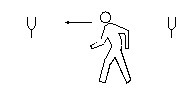
Ans. 4.6 Hz
71. Figure shows a person standing somewhere in between two identical tuning forks, each vibrating at 512 Hz. If both the tuning fork move towards right at a speed of 5.5 m/s, find the number of beats heard by the listener. Speed of sound in air = 330 m/s.

Ans. 17.5 Hz, may not be able to distinguish
72. A small source of sound vibrating at frequency 500 Hz is rotated in a circle of radius 100/p cm at a constant angular speed of 5.0 revolutions per second. A listener situates himself in the plane of the circle. Find the minimum and the maximum frequency of the sound observed. Speed of sound in air = 332 m/s.
Ans. 485 Hz and 515 Hz
73. Two trains are travelling towards each other both at a speed of 90 km/h. If one of the trains sounds a whistle at 500 Hz, what will be the apparent frequency heard in the other train ? Speed of sound in air = 350 m/s.
Ans. 577 Hz
74. A traffic policeman sound a whistle to stop a car-driver approaching towards him. The car-driver does not stop and takes the plea in court that because of the Doppler shift, the frequency of the whistle reaching him might have gone beyond the audible limit of 20 kHz and he did not hear it. Experiments showed that the whistle emits a sound with frequency close to 16 kHz. Assuming that the claim of the driver is true, how fast was he driving the car? Take the speed of sound in air to be 330 m/s. Is this speed partical with today’s technology?
Ans. 300 km/h
75. A car moving at 108 km/h finds another car in front of it going in the same direction at 72 km/h. The first car sounds a horn that has a dominant frequency of 800 Hz. What will be the apparent frequency heard by the driver in the front car? Speed of sound in air = 330 m/s.
Ans. 827 Hz
76. Two submarines are approaching each other in a calm sea. The first submarine travels at a speed of 36 km/h and the other at 54 km/h relative to the water. The first submarines sends a sound signal (sound waves in water are also called sonar) at a frequency of 2000 Hz. (a) At what frequency is this signal received by the second submarine ? (b) The signal is reflected from the second submarine. At what frequency is this signal received by the first submarine. Take the speed of the sound wave in water to be 1500 m/s.
Ans. (a) 2034 Hz (b) 2068 Hz
77. A small source of sound oscillates in simple harmonic motion with an amplitude of 17 cm. A detector is placed along the line of motion of the source. The source emits a sound of frequency 800 Hz which travels at a speed of 340 m/s. If the width of the frequency band detected by the detector is 8 Hz, find the time period of the source.
Ans. 0.63 s
78. A boy riding on his bike is going towards east at a speed of 4X20.5m/s. At a certain point he produces a sound pulse of frequency 1650 Hz that travels in air at a speed of 334 m/s. A second boy stands on the ground 45° south of east from him. Find the frequency of the pulse as received by the second boy.
Ans. 1670 Hz
79. A sound source, fixed at the origin is continuously emitting sound at a frequency of 660 Hz. The sound travels in air at a speed of 330 m/s. A listener is moving along the line x= 336 m/s. A listener is moving along the line x = 336 m at a constant speed of 26 m/s. Find the frequency of the sound as observed by the listener when he is (a) at y = – 140 m, (b) at y = 0 and (c) at y = 140 m.
Ans. (a) 680 Hz (b) 660 Hz (c) 640 Hz
80. A train running at 108 km/h towards east whistles at a dominant frequency of 500 Hz. Speed of sound in air is 340 m/s. What frequency will a passenger sitting near the ope window hear? (b) What frequency will a person standing near the track hear whom the train has just passed? (c) A wind starts blowing towards east at a speed of 36 km/h. Calculate the frequencies heard by the passenger in the train and by the person standing near the track.
Ans. (a) 500 Hz (b) 459 Hz (c) 500 Hz by the passanger and 458 by the person near the track
81. A boy riding on a bicycle going at 12 km/h towards a vertical wall wishes at his dog on the ground. If the frequency of the whistle is 1600 Hz and the speed of sound in air is 330 m/s, find (a) the frequency of the whistle as received by the wall (b) the frequency of the reflected whistle as received by the boy.
Ans.(a) 1616 Hz (b) 1632 Hz
82. A person standing on a road sends a sound signal to the driver of a car going away from him at a speed of 72 km/h. The signal travelling at 330 m/s in air and having a frequency of 1600 Hz gets reflected from the body of the car and returns. Find the frequency of the reflected signal as heard by the person.
Ans. 1417 Hz
83. A car moves with a speed of 54 km/h towards a cliff. The horn of the car emits sound of frequency 400 Hz at a speed f 335 m/s. (a) Find the wavelength of the sound emitted by the horn in front of the car. (b) Find the wavelength of the wave reflected from the cliff. (c) What frequency does a person sitting in the car hear for the reflected sound wave? (d) How many beats does he hear in 10 seconds between the sound coming directly from the horn and that coming after the reflection?
Ans. (a) 80 cm (b) 80 cm (c) 437 hz (d) No beat may be heard
84. An operator sitting in his base camp sends a sound signal of frequency 400 hz. The signal is reflected back from a car moving towards him. The frequency of the reflected sound is found to be 410 hz. Find the speed of the car. Speed of sound in air = 324 m/s.
Ans. 12 m/s
85. Figure shows a source of sound moving along the X-axis at a speed of 22 m/s continuously emitting a sound of frequency 2.0 kHz which travels in air at a speed of 330 m from the origin. At t = 0, the source crosses the origin P. (a) When does the sound emitted from the source at P reach the listener Q? (b) What will be the frequency heard by the listener at this instant? (c) Where will the source be at this instant ?
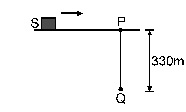
Ans. (a) t = 1 sec (b) 2.0 k Hz (c) at x = 22 metre
86. A source emitting sound at frequency 4000 Hz, is moving along the Y-axis with a speed of 22m/s. A listener is situated on the ground at the point (660 m, 0). Find the frequency of the sound received by the listener at the instant the source crosses the origin. Speed of sound in air = 330m/s.
Ans. 4018 Hz
87. A source of sound emitting a 1200 Hz note travels along a straight line at a speed of 170 m/s. A detector is placed at a distance of 200 m from the line of motion of the source. (a) Find the frequency of sound received by the detector at the instant when the source gets closest to it. (b) Find the distance between the source and the detector at the instant is detects the frequency 1200 Hz. Velocity of sound in air = 340 m/s.
Ans. (a) 1600 Hz (b) 224 m
88. A small source of sound S of frequency 500 Hz is attached to the end of a light string and is whirled in a vertical circle of radius 1.6 m. The string just remains tight when the source is at the highest point. (a) An observer is located in the same vertical plane at a large distance and at the same height as the centre of the circle (figure). The speed of sound in air = 330 m/s and g 10 m/s2. Find the maximum frequency heard by the observer. (b) An observer is situated at a large distance vertically above the centre of the circle. Find the frequencies heard by the observer corresponding to the sound emitting by the source when it is at the same height as the centre.
![]()
Ans. (a) 506 Hz (b) 490 Hz and 511 Hz
89. A source emitting a sound of frequency v is placed at a large distance from an observer. The source starts moving towards the observer with a uniform acceleration a. Find the frequency heard by the observer corresponding to the wave emitted just after the source starts. The speed of sound in the medium is v.
Ans. 2uv2 / 2uv-a